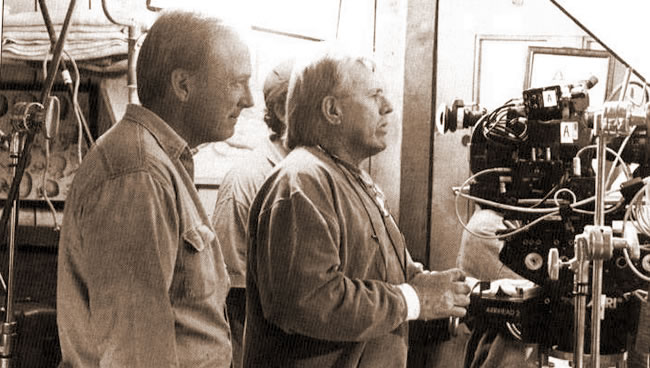RANCH HANDS
Despite 12 hour days and temperature extremes, "Medicine Woman"
is still a walk in the park.. By Wolf Schneider |

The staff writer-producers follow their scripts into production, which helps keep the stories intact. -'It's very unusual and wonderful to have the opportunity to shepherd your project through." says Gerson. who revels in the outdoor setting.
With the Western town set just two blocks away from the offices, writers
often hurrying down the dusty road and across the bridge, onto the four-acre
set. Most of the action takes place within a
three-block radius.
This afternoon. like most afternoons, the horses are standing tranquilly in the sun light, loosely tied to hitching posts and slurping from their water troughs. Inside the clinic, the cameras are rolling as the Reverend is told he needs his tonsils removed. Small touches. like the bunches of herbs and garlic hung from the wooden roof give the clinic a cozy touch.
The clinic's ivory lace curtains are tied aside to allow the natural light to stream through-and to permit cinematographer Oxxie Smith and director James Keach to film the action on teh street as well as in the clinic.
"We're always shooting from the inside to the outside, since the story's about a town and the people in the town," says Smith. 'I don't just let the outside exterior blow out and be dull. I have a great deal of background going, plus the scene going on inside. That's one of the keys to this show: Something's moving inthat frame all the time."
Directors may come and go, but Smith is a constant. "If we're inside the clinic or the general store," he advises them, "we always try to stage the scene against a window so we can see the town outside: the horses, the buggies, the costumes. I know how much it costs for all that stuff. I figure, if the network's gonna pay for it, we're gonna see it."
Keeping interiors and exteriors light-balanced and in focus is tricky. The show is shot film-style, with two cameras usually opeating, there is also a heavy reliance on source lighting-which means keying the light to sunlight, lanterns and other natural sources. Shooting with 16 mm stock, Smith relies on 7245 and 7248 Eastman Kodak film, the former with a 50 ASA for shooting during daylight, and the latter with a 100 ASA for shooting night interiors and exteriors.
"The period look is all done with the lighting and the type of film I use. That's the key. We use the low ASA film so we can get the richness and the blacks and the depth, even durin gthe day," says Smith. He admits he hasd help from some far-thinking individuals he never met: the folks who originally built this Western town in 1927.
"The way the town is set up from years ago, for the major sets usually everything is backlit. So it makes it a little easier "
Working 46 weeks a year and shooting 28 episodes a season, days are long on the "Medicine Woman " set. where a typical morning starts at 7 a.m.
"Nowadays, we only shoot twelve-hour days. so it's a lot better than it used to be." remarks, Jane Seymour. who recalls 16 hour days in the past. "If they shoot 12 hours add on an hour and a half for me for hair and make-up, so if they do a 12-hour day, I do a 13 and a half hour day:"
On a five-day work week. the production team goes through about eight to nine script pages a day.. "If it's (a)nine-page day, that's usually because I have long dialogue like a speech or something. because that doesn't take them as long to shoot," Seymour says.
But who's complaining? Certainly not Seymour. who got cast one day belore the pilot began production. "I basically told my agents and everyone concerned that I was never going to do a series. I changed my mind one day and said I needed to work. I was going through a bad divorce and I had to work. My agent called me and said. 'There's a pilot which people don't think will go as a series, but it's a wonderful part, a terrific character."' Seymour (whose own father is a doctor and who had shared many of his travails) immediately responded.
"They had written this part for me, it seems, although we all know they hadn't. It was just by fate that it was written so similar to my own story.- she says. "Also, the whole thing like fish out of water. I feel very much a part of America now, and Califomia, but the fact is that I'm still very English. That's my deep roots, and of course Michaela has the same thing with Boston." In her fourth year on the series, Seymour recently renegotiated her contract. "I just signed for another six. 1 guess they're looking at 10." she says.
With night falling, Seymour has one last shot to do. It's a tender kiss goodbye with Joe Lando who's headed off to track some bad guys. Petite as she is, Seymour climbs up on a small box so their height will be more evenly matched. Movie lamps are crammed into the one-room clinic now along with the examining table, Michaela's medicines, and crew members huddling together to keep warm as the temperature outside plummets with the darkness.
"OK, let's go;' says director Keach. Seymour and Lando share an
intimate moment - despite the peering eyes of two-dozen crew members
- and it's a wrap.